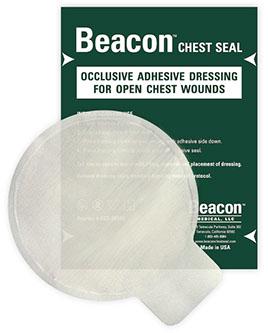In emergency medicine, time is often the difference between life and death. When a person suffers a traumatic injury, especially to the chest, prompt action can be the key to survival. One essential tool in the fight to save lives in such situations is the vented chest seal. While it may seem like a small, simple item, this life-saving device plays a crucial role in preventing fatal complications like tension pneumothorax, which occurs when air becomes trapped in the chest cavity.
Understanding how a vented chest seal works, why it's vital in trauma situations, and how it can make all the difference during an emergency can help you be better prepared to act in life-threatening situations. Let’s take a closer look at the importance of this device, how it functions, and why having one on hand could save a life.
The Power of Immediate Response in Trauma
Trauma injuries, especially penetrating wounds such as gunshots, stabbings, or blunt force trauma, can lead to life-threatening conditions in a matter of moments. When the chest is involved, complications can escalate quickly. One of the most serious conditions that can result from a chest wound is a pneumothorax, a condition where air enters the pleural space between the chest wall and the lungs. This air pressure can collapse the lung, and if not treated immediately, it can cause the heart to shift, severely restricting the body's ability to breathe and circulate oxygen.
In trauma situations, immediate medical intervention is critical. That's where a vented chest seal comes in. This simple yet effective tool can dramatically reduce the risk of serious injury, potentially saving lives before paramedics or medical professionals are able to arrive on the scene.
What Is a Vented Chest Seal?
A vented chest seal is a specialized bandage designed to cover a chest wound, creating a one-way valve system that allows air to escape while preventing more air from entering the chest. This valve helps to avoid the development of tension pneumothorax, a fatal condition where air continues to build up in the chest without being able to escape.
The seal itself is usually made from a flexible, adhesive material and is equipped with a small vent or valve. When applied to a chest wound, it sticks to the skin around the injury, forming a barrier that lets air escape but prevents it from entering. In doing so, it helps to relieve the increasing pressure inside the chest and stabilizes the injury until more advanced medical treatment can be provided.
How a Vented Chest Seal Works in Trauma Situations
The purpose of a vented chest seal is simple: prevent air from entering the chest cavity while allowing it to escape. Without this mechanism, trapped air can cause the lung to collapse and pressure to build, leading to severe and often fatal complications. Let’s break it down further:
- Stopping Air from Entering: When a person suffers a penetrating chest injury, air can be drawn into the chest cavity every time the injured person breathes in. The vented chest seal prevents this by adhering tightly to the wound. This is crucial because the constant influx of air can lead to tension pneumothorax, where air accumulates in the chest cavity and pushes on the lungs and heart.
- Allowing Air to Escape: As the chest seal is applied, the one-way valve allows air that is already in the cavity to escape through the vent. Without a vented chest seal, this trapped air would cause pressure to build up and could result in a collapsed lung, which in turn makes breathing even harder.
- Stabilizing the Victim: By using the vented chest seal to manage the flow of air in and out of the chest, it helps keep the victim stable. This is especially important in situations where medical help may not be immediately available, such as in remote locations or during combat situations.
Why It’s So Important in Trauma Situations
A vented chest seal is a game-changer in trauma care, particularly when seconds matter. Here’s why it’s so critical:
- Prevents Tension Pneumothorax: This condition is a leading cause of preventable death in trauma situations. By sealing the wound and allowing air to escape, the vented chest seal helps reduce the risk of this dangerous complication.
- Quick Application: A vented chest seal can be applied quickly by anyone with basic first-aid training. This means that even bystanders or non-medical personnel can play a vital role in stabilizing the injured person until emergency services arrive.
- Compact and Portable: Vented chest seals are lightweight and easy to carry. Whether in a first-aid kit, trauma bag, or emergency pack, they are a simple but essential item for anyone who may be in a position to assist in an emergency situation.
- Effective in Various Wound Types: Whether the chest injury is from a gunshot wound, stab wound, or blunt trauma, the vented Chest seal can be applied to cover the wound, making it an incredibly versatile and adaptable tool in various trauma situations.
How to Apply a Vented Chest Seal
Applying a vented chest seal isn’t complicated, but it’s essential to do it correctly to ensure effectiveness. Here’s a simple guide:
- Assess the Wound: Before applying the seal, assess the chest wound. If the wound is open and air is bubbling out of the chest, it’s important to act immediately to prevent air from being drawn in.
- Position the Seal: Remove the backing from the chest seal and place it directly over the wound. Make sure the seal covers the entire wound to prevent air from entering.
- Apply Firm Pressure: Press the seal firmly around the edges to ensure it adheres securely to the skin. The vent will be on the upper portion of the seal, allowing trapped air to escape as the patient breathes.
- Monitor the Patient: After the seal is applied, monitor the patient’s condition closely. If the patient’s breathing becomes more labored, or if you notice a worsening of symptoms, seek emergency medical help immediately.
The Bottom Line: Life-Saving Potential in Trauma Situations
In moments of trauma, when every second counts, having the right tools on hand can make the difference between life and death. A vented chest seal is a simple yet powerful device that can provide vital support in preventing fatal conditions like tension pneumothorax. By stabilizing the wound and allowing trapped air to escape, it offers a crucial lifeline to victims of penetrating chest injuries.
Whether you're a first responder, military personnel, or someone who simply wants to be prepared in case of an emergency, understanding how a vented chest seal works and knowing how to apply it could save a life. By taking swift action with the right equipment, you can help provide the victim with the best possible chance of survival in those critical moments.






